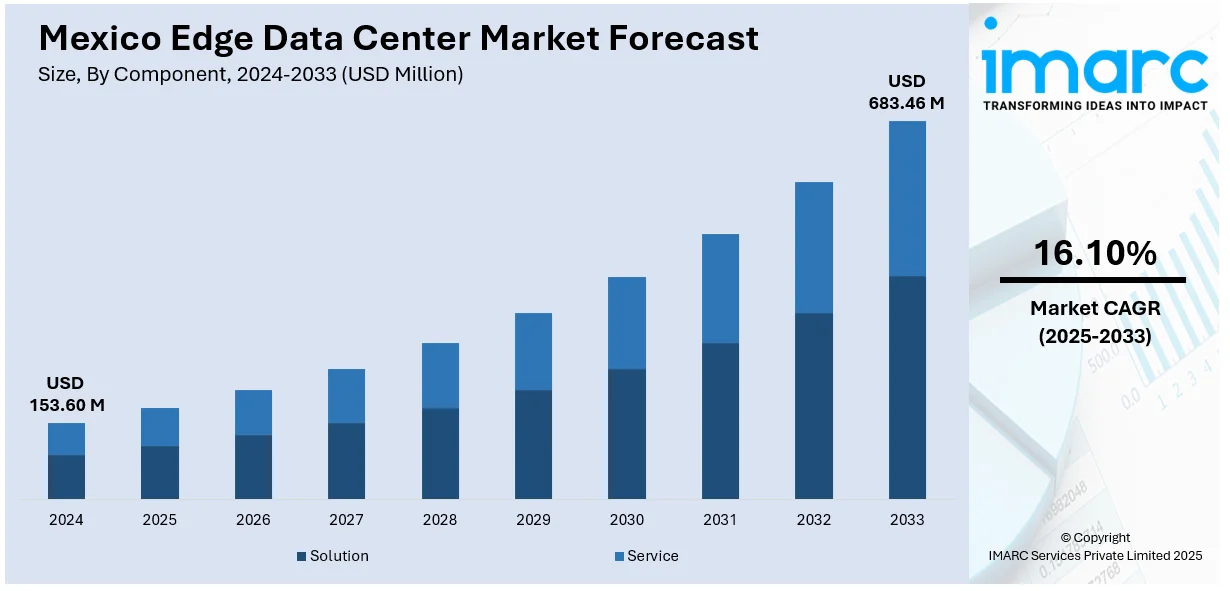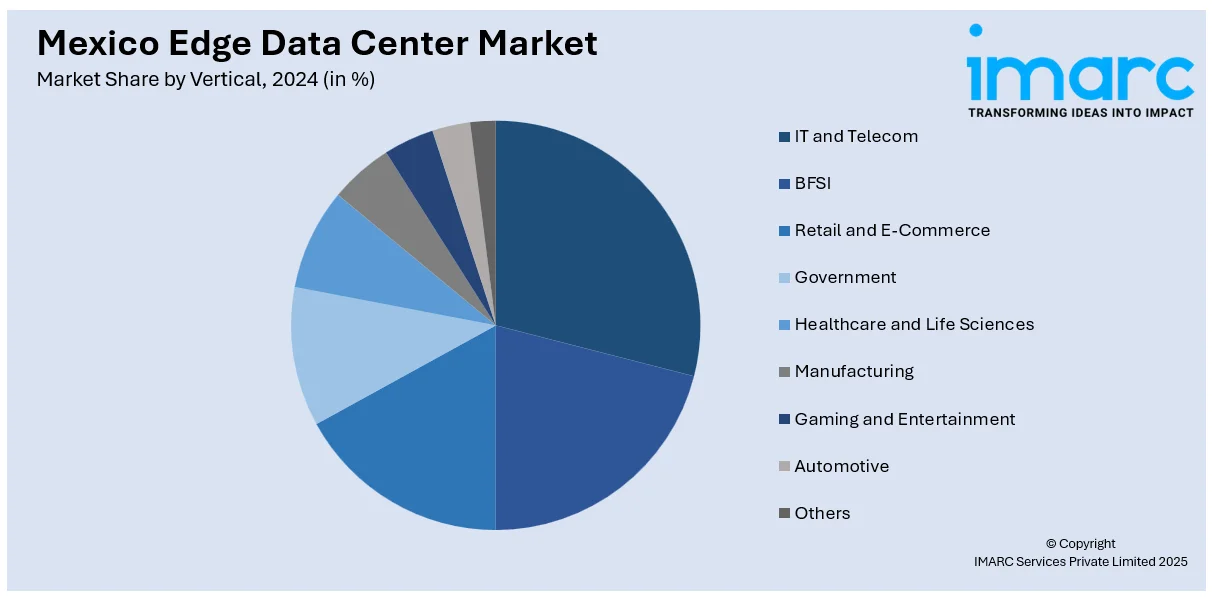
Mexico Edge Data Center Market Size, Share, Trends and Forecast by Component, Facility Size, Vertical, and Region, 2025-2033
Mexico Edge Data Center Market Overview:
The Mexico edge data center market size reached USD 153.60 Million in 2024. Looking forward, IMARC Group expects the market to reach USD 683.46 Million by 2033, exhibiting a growth rate (CAGR) of 16.10% during 2025-2033. The market is being fueled by the fast internet penetration, growing use of smartphones, and the booming use of video streaming and IoT applications. Increased demand for low-latency computing, along with the deployment of 5G networks, is driving enterprises and telecom operators to adopt edge infrastructure. Government incentives for digital transformation and increasing investment in smart city projects are other important factors augmenting the Mexico edge data center market share.
|
Report Attribute
|
Key Statistics
|
|---|---|
|
Base Year
|
2024
|
|
Forecast Years
|
2025-2033
|
|
Historical Years
|
2019-2024
|
| Market Size in 2024 | USD 153.60 Million |
| Market Forecast in 2033 | USD 683.46 Million |
| Market Growth Rate 2025-2033 | 16.10% |
Mexico Edge Data Center Market Trends:
Surge in Regional Cloud and Content Delivery Networks (CDNs) Expansion
The rising demand for cloud computing and content delivery in Mexico is prompting global and regional providers to expand their local infrastructure footprints. Major cloud service providers (CSPs) such as AWS, Google Cloud, and Microsoft Azure are either partnering with local data center operators or establishing their edge nodes to reduce latency and enhance service performance. This trend is further reinforced by the growing consumption of video content, online gaming, and e-commerce platforms, all of which require fast, localized data delivery to ensure smooth user experiences and minimal latency. Video streaming, with platforms such as YouTube witnessing steady growth in user engagement. As of early 2025, Mexico had 83.6 million YouTube users. During the period from early 2024 to early 2025, YouTube’s potential ad reach in the country increased by approximately 500,000 users, representing a 0.6% year-on-year growth. This sustained rise in digital media consumption is placing pressure on cloud and content providers to deploy edge data centers that can cache content closer to end users, thereby reducing latency and improving service delivery. In addition to this, content delivery networks (CDNs) are deploying edge nodes closer to end users in Tier 2 and Tier 3 cities, which is creating demand for compact, scalable edge facilities. Moreover, the availability of dark fiber and improved last-mile connectivity is also enabling efficient CDN deployment. As organizations prioritize user experience and data sovereignty, edge data centers are used to host cached content, virtual machines, and microservices.

Integration of Edge Infrastructure with 5G Rollouts
Mexico’s telecom operators are actively rolling out 5G networks across major cities, and edge data centers are becoming essential to support this transformation. This, in turn, is propelling the Mexico edge data center market growth. For instance, as of Q1 2024, approximately 13.0 million Mexican mobile lines, representing around 9.1% of the country’s total, were already connected to the 5G network. This growing user base is accelerating the need for localized data processing and bandwidth optimization, further solidifying the role of edge data centers in supporting telecom infrastructure, IoT systems, and real-time digital services across the country. Moreover, 5G requires ultra-low latency and distributed computing to meet its promise of high-speed, real-time connectivity for applications like autonomous systems, remote surgeries, and industrial IoT. To fulfill these requirements, telecom providers are collocating micro data centers at base stations, fiber aggregation points, and metro network hubs, which enables rapid data processing at the edge of the network. Apart from this, edge data centers also assist in offloading data traffic from the core, preventing network congestion and improving the quality of service. In this context, strategic partnerships between telcos and neutral host data center providers are gaining momentum. These collaborations allow for shared infrastructure usage, optimized energy consumption, and faster deployment timelines.
Mexico Edge Data Center Market Segmentation:
IMARC Group provides an analysis of the key trends in each segment of the market, along with forecasts at the country and regional levels for 2025-2033. Our report has categorized the market based on component, facility size, and vertical.
Component Insights:
- Solution
- Service
The report has provided a detailed breakup and analysis of the market based on the component. This includes solution and service.
Facility Size Insights:
- Small and Medium Facility
- Large Facility
A detailed breakup and analysis of the market based on the facility size have also been provided in the report. This includes small and medium facility and large facility.
Vertical Insights:

- IT and Telecom
- BFSI
- Retail and E-Commerce
- Government
- Healthcare and Life Sciences
- Manufacturing
- Gaming and Entertainment
- Automotive
- Others
The report has provided a detailed breakup and analysis of the market based on the vertical. This includes IT and telecom, BFSI, retail and e-commerce, government, healthcare and life sciences, manufacturing, gaming and entertainment, automotive, and others.
Regional Insights:
- Northern Mexico
- Central Mexico
- Southern Mexico
- Others
The report has also provided a comprehensive analysis of all the major regional markets, which include Northern Mexico, Central Mexico, Southern Mexico, and others.
Competitive Landscape:
The market research report has also provided a comprehensive analysis of the competitive landscape. Competitive analysis such as market structure, key player positioning, top winning strategies, competitive dashboard, and company evaluation quadrant has been covered in the report. Also, detailed profiles of all major companies have been provided.
Mexico Edge Data Center Market Report Coverage:
| Report Features | Details |
|---|---|
| Base Year of the Analysis | 2024 |
| Historical Period | 2019-2024 |
| Forecast Period | 2025-2033 |
| Units | Million USD |
| Scope of the Report |
Exploration of Historical Trends and Market Outlook, Industry Catalysts and Challenges, Segment-Wise Historical and Future Market Assessment:
|
| Components Covered | Solution, Service |
| Facility Sizes Covered | Small and Medium Facility, Large Facility |
| Verticals Covered | IT and Telecom, BFSI, Retail and E-Commerce, Government, Healthcare and Life Sciences, Manufacturing, Gaming and Entertainment, Automotive, Others |
| Regions Covered | Northern Mexico, Central Mexico, Southern Mexico, Others |
| Customization Scope | 10% Free Customization |
| Post-Sale Analyst Support | 10-12 Weeks |
| Delivery Format | PDF and Excel through Email (We can also provide the editable version of the report in PPT/Word format on special request) |
Key Questions Answered in This Report:
- How has the Mexico edge data center market performed so far and how will it perform in the coming years?
- What is the breakup of the Mexico edge data center market on the basis of component?
- What is the breakup of the Mexico edge data center market on the basis of facility size?
- What is the breakup of the Mexico edge data center market on the basis of vertical?
- What is the breakup of the Mexico edge data center market on the basis of region?
- What are the various stages in the value chain of the Mexico edge data center market?
- What are the key driving factors and challenges in the Mexico edge data center?
- What is the structure of the Mexico edge data center market and who are the key players?
- What is the degree of competition in the Mexico edge data center market?
Key Benefits for Stakeholders:
- IMARC’s industry report offers a comprehensive quantitative analysis of various market segments, historical and current market trends, market forecasts, and dynamics of the Mexico edge data center market from 2019-2033.
- The research report provides the latest information on the market drivers, challenges, and opportunities in the Mexico edge data center market.
- Porter's five forces analysis assist stakeholders in assessing the impact of new entrants, competitive rivalry, supplier power, buyer power, and the threat of substitution. It helps stakeholders to analyze the level of competition within the Mexico edge data center industry and its attractiveness.
- Competitive landscape allows stakeholders to understand their competitive environment and provides an insight into the current positions of key players in the market.
Need more help?
- Speak to our experienced analysts for insights on the current market scenarios.
- Include additional segments and countries to customize the report as per your requirement.
- Gain an unparalleled competitive advantage in your domain by understanding how to utilize the report and positively impacting your operations and revenue.
- For further assistance, please connect with our analysts.
 Request Customization
Request Customization
 Speak to an Analyst
Speak to an Analyst
 Request Brochure
Request Brochure
 Inquire Before Buying
Inquire Before Buying




.webp)




.webp)












